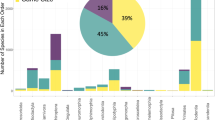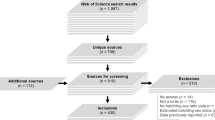Similar content being viewed by others
Main
The main problem is that it assumes an invariant relative size at maturity, which follows from two of the dimensionless invariants assumed by Charnov's model6: α·M and k/M (where α is the age at first breeding; M is the adult mortality rate; and k is the relative growth rate, or Bertalanffy coefficient). If these are invariant, then their product α·k is invariant, and so the relative size at maturity (Lmat/Lmax = 1 − exp(−α·k)) is also invariant. These are the crucial invariants for Charnov's model, so we would expect the null model of Buston et al. to produce an invariant relative size at sex change, and hence to fit our data. If an invariant relative size at maturity is not assumed, then more appropriate null models can be developed (for example, (Lmat/Lmax ∼ U[0,1], L50/Lmax ∼ U[Lmat/Lmax, 1]) and the predictions of these differ significantly from the observed data (A. Gardner, E. Charnov, D.J.A. and S.A.W., manuscript in preparation; simulation results, P<0.0001).
There are other problems with the model of Buston et al. First, the distribution of relative size at sex change in the actual data is significantly different from the uniform distribution they assume (for fish: P0.000001; for all species: P0.02). More generally, invariance is statistical — it does not imply that all individuals do exactly the same thing3,4.
Second, they arbitrarily assign a size at maturity of 50% of maximum body size. This forces their model to fit the data, giving an average size at sex change of 75% of maximum body size (observed is 72%). Their citation4 actually suggests that 50% is a lower bound, with an average value of 65%, which would give a mean size at sex change of 83%, far from the observed.
Third, the assumption of a uniform distribution in relative size at sex change assumes no selection on size at sex change, which is not the case4,7,8. Fourth, the model of Buston et al. and our version are both unrealistic ‘straw men’, easily knocked down, as shown here.
A more powerful and informative approach is to carry out a sensitivity analysis of Charnov's model6 and test how variation in different parameters influences the relative size at sex change and its variation. We are doing this (A. Gardner, E. Charnov, D.J.A. and S.A.W., manuscript in preparation) and have found that the prediction of an invariant size at sex change relies primarily on invariance in α·M and k/M, with variation in δ — the coefficient relating male fertility to size — having little effect. This explains the results of the null model of Buston et al. (which does not assume an invariant δ) and explains why breeding system and taxa do not significantly influence the relative size at sex change2.
Buston et al. suggest that variation within species provides problems for our invariant result. However, this criticism misses the purpose of cross-species comparative studies5,9,10. The aim is to look for general patterns across species — this does not imply that there is no within-species variation. For example, α is often facultatively adjusted within species11, but this does not disrupt the aüM invariant4. The study of variation across and within species should be seen as complementary approaches, not alternatives. Our results2 indicate that Charnov’s model6 efficiently encapsulates the crucial aspects of the underlying biology.
We agree that relative size and social context will influence the advantage and timing of sex change for specific individuals, and that the importance of this varies across species (in contrast to the assumptions made by Buston et al. in their model)7,8. However, our results indicate that these effects may average out, so the relationship between size and fitness can be approximated extremely well by a single positive relationship for each sex. It is a statistical fact that biological details matter for the timing of when individuals change sex, but not for explaining the average pattern across species.
Our approach is based on fundamental assumptions and evolutionary theory developed over the past 30 years4,7,8,9. The novelty lies in the predictions of these models being phrased in terms of dimensionless qualities that are invariant and determining the consequences for general patterns of sex change2,4,6.
References
Buston, P. M., Munday, P. L. & Warner, R. R. Nature doi:10.1038/nature02512 (2004).
Allsop, D. J. & West, S. A. Nature 425, 783–784 (2003).
Brown, J. H., West, G. B. & Enquist, B. J. in Scaling in Biology (eds Brown, J. H. & West, G. B.) 1–24 (Oxford University Press, Oxford, 2000).
Charnov, E. L. Life History Invariants (Oxford University Press, Oxford, 1993).
Harvey, P. H. & Pagel, M. D. The Comparative Method in Evolutionary Biology (eds May, R. M. & Harvey, P. H.) (Oxford University Press, Oxford, 1991).
Charnov, E. L. & Skuladottir, U. Evol. Ecol. Res. 2, 1067–1071 (2000).
Charnov, E. L. The Theory of Sex Allocation (Princeton University Press, Princeton, 1982).
Leigh, E. G., Charnov, E. L. & Warner, R. R. Proc. Natl Acad. Sci. 73, 3655–3660 (1976).
Frank, S. A. Foundations of Social Evolution (Princeton University Press, Princeton, 1998).
Allsop, D. J. & West, S. A. Evolution (in the press).
Stearns, S. C. The Evolution of Life Histories (Oxford University Press, Oxford, 1992).
Author information
Authors and Affiliations
Corresponding author
Rights and permissions
About this article
Cite this article
Allsop, D., West, S. Sex change and relative body size in animals (reply). Nature 428, 2 (2004). https://doi.org/10.1038/nature02513a
Issue Date:
DOI: https://doi.org/10.1038/nature02513a
Comments
By submitting a comment you agree to abide by our Terms and Community Guidelines. If you find something abusive or that does not comply with our terms or guidelines please flag it as inappropriate.



